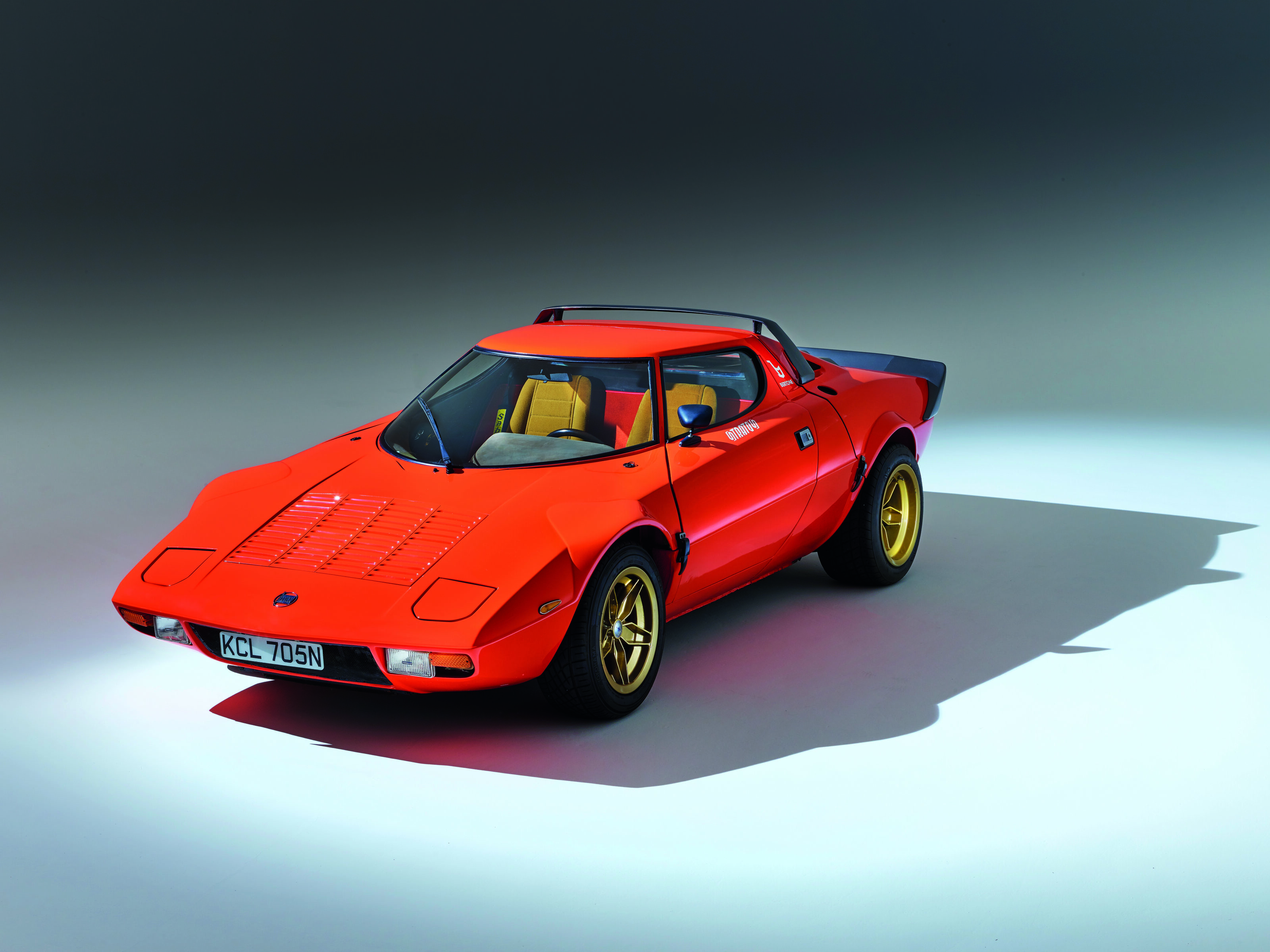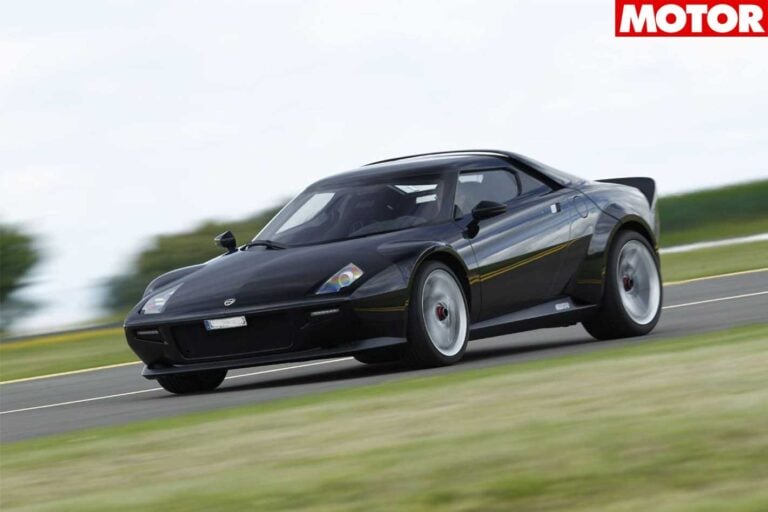Imagine a state-of-the-art supersonic fighter jet being produced and its maker being told, “You have to sell 500 to the public before you can fly it”. That may sound ludicrous, yet it’s not far off what happened for the genuinely iconic, unorthodox and unstoppable 1973 Lancia Stratos HF Stradale. A mid-engined, compact spaceship penned by a Lamborghini designer and powered by a free-revving Ferrari engine, it was utterly gobsmacking – and a political struggle from the start.
This was not an existing road car modified to the extreme – the Stratos was created with the sole purpose of winning the newly instituted World Rally Championship (WRC). The result of Lancia’s motorsport ambition, the road version existed purely because it was mandated by FIA Group 4 regulations. Otherwise, this was a corner carving, hump jumping, snow, dirt and gravel king created from inception to take rallying by storm.
Competition had always been in Lancia’s psyche, Vincenzo Lancia a racing driver himself when he and engineer Claudio Fogolin formed the company in 1906. Yet with debts mounting, the struggling brand faced its second bankruptcy in as many decades before rival Fiat bought it in 1969.
While its new owners looked to reinvigorate the brand, there was immediate tension between the individuality of ‘La Lancia’ and corporate pragmatism of Fiat. It festered with the Stratos project, objectors wondering how a low-volume sports car would help return Lancia to profitability. That was before the oil crisis…
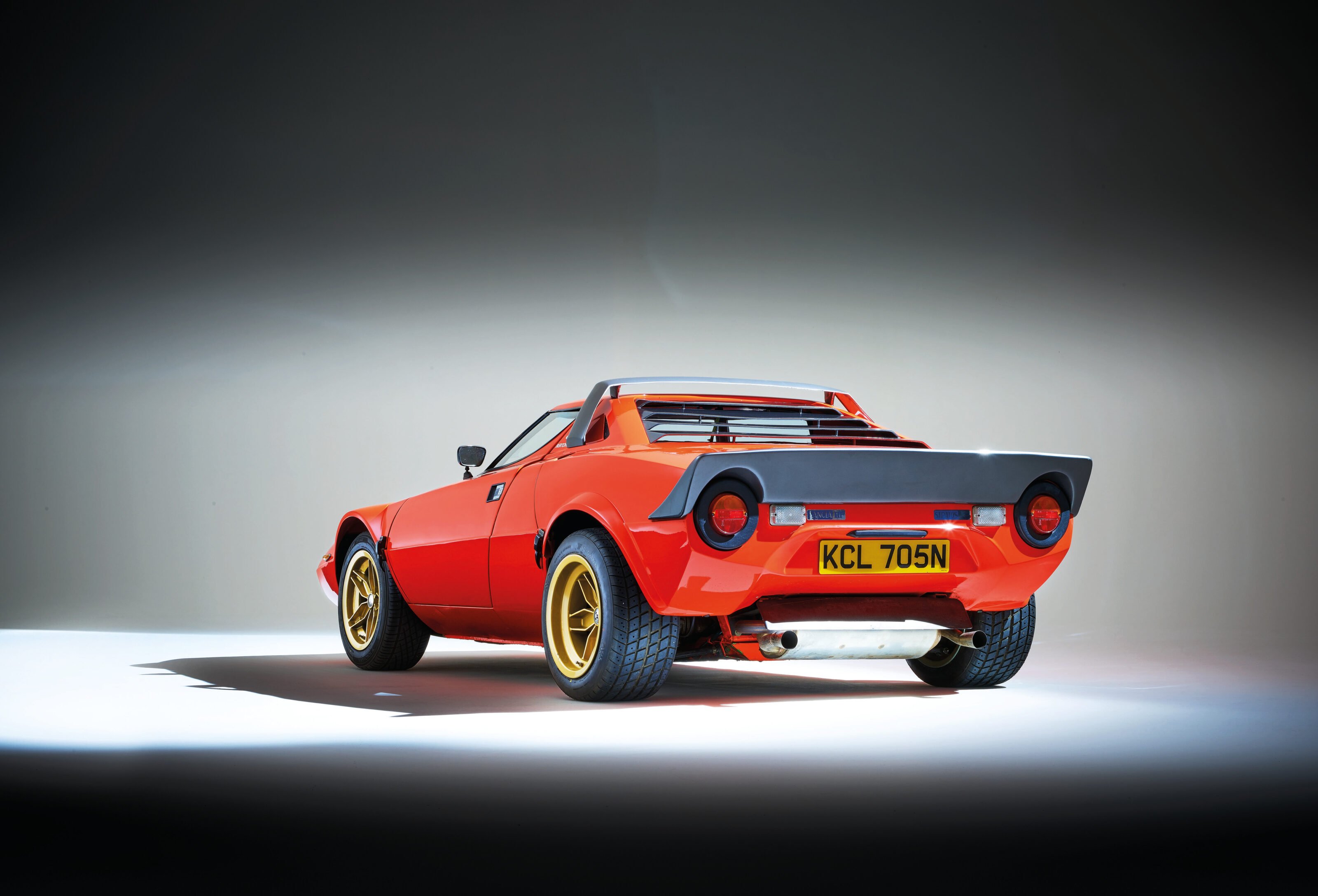
Across town Bertone was looking for a way into Lancia, too, as another rivalry was bubbling. Keen to steal a march on Pininfarina, Bertone’s Marcello Gandini, who gifted the world the Lamborghini Miura and then the Countach, daringly produced the wondrous, oh-so-seventies Stratos Zero concept.
The sparkling orange Stratos Zero stunned the 1970 Turin show with its dramatic, low nose and impossible wedge. Legend has it that Nuccio Bertone drove the 840mm-high Zero concept to Via Vincenzo Lancia – and straight under Grattacielo Lancia’s boomgate. It wasn’t just a ticket under the boomgate: it was Bertone’s expensive bid to design the Stratos HF (High Fidelity). It worked.
The brief for the Stratos HF was clear: win rallies. Initially, Fiat wanted Lancia to build a rally car that was intentionally heavy and sturdy, with high ground clearance and no need for a top-speed beyond 150km/h. Yet Lancia competition boss, Cesare Fiorio, demanded its new rally competitor be gifted with speed. The Stratos had to be fast on the smooth asphalt of Corsica, the dry dust and mud of Kenya’s Safari Rally, and carve through the bitter snow of Sweden.
Gandini worked swiftly, and the Stratos HF Concept was ready for the 1971 Turin show. The world had never seen such a wild, bold Lancia: finished in Day-Glo red with gold alloys, its aggressive posture and radical wedge profile saw a constant-radius front windscreen coalesce with its tapering side windows. The design barely changed for the production version, shown 12 months later.
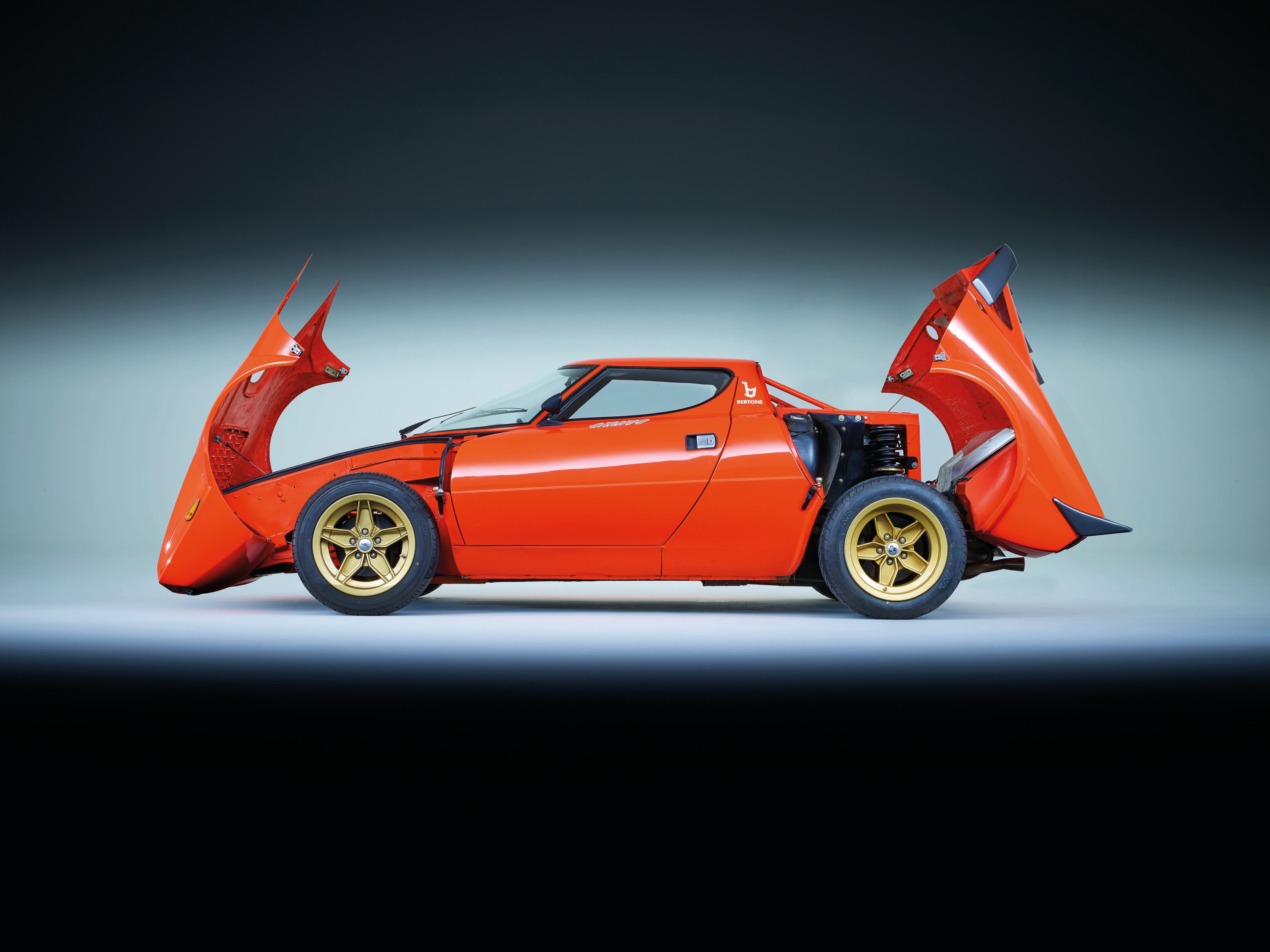
Literally a clean-sheet design, the Stratos’s compact proportions saw a central bulkhead anchor two seats and a mid-mounted engine for clever packaging that delivered inherent manoeuvrability and minimal weight. At 3710mm, it was shorter than the diminutive Alpine A110, the stumpy 2180mm wheelbase was a massive 220mm less than the then-new Mk 1 VW Golf, and 160mm less than a Dino’s. It was low, too, sitting only 45mm higher than the out-of-this-world Countach.
Former Wheels editor, Ian Fraser, writing in CAR in 1979, described the “amazingly compact” Stratos as, “One of Bertone’s most outstanding designs and a classic from the outset … Sleek from any angle, it exudes purposefulness”. Fraser was writing after buying his very own Stratos at the encouragement of fellow scribe, Georg Kacher, such was the Lancia’s impact on even hard-nosed journalists.
Underneath the lightweight fibreglass body – chosen over aluminium for cost and superior rally repairability – was an ultra-stiff steel monocoque with front and rear subframes. Designed by the legendary Gian Paolo Dallara with brilliant engineer Mike Parkes, it included an integrated roll-cage and front and rear clips, again for easy access to the Stratos’s mechanicals.
Suspension saw anti-roll bars at each end, with double-wishbones up front and upright MacPherson-type adjustable rear struts, chosen for greater travel and ease of changing wheel sizes. It was reinforced by significant underbody protection. Developed by legendary test driver, Claudio Maglioni, this was no beefed-up road car but an out-and-out competition monster.

Opening the rear clip to reveal the glorious Dino V6 is typically a two-person job. Yet on the production car’s debut at Turin, a powerplant was still to be secured. The Dino V6 was desired for its compact size, light weight and power, Gandini designing the Stratos HF for the Dino V6 and synchromesh five-speed dogbox from the beginning. Yet politics almost scuttled it – and the entire Stratos project with it.
Fiat owned the keys to Ferrari’s road-car business, and while chief Umberto Agnelli somewhat supported the Stratos project, many key Fiat executives remained opposed. It’s suggested that Ferrari, too, saw the Stratos as a showroom rival to the Dino 246GT. This saw progress stalled by both Fiat and Ferrari whenever possible when it came to supplying the Dino V6.
Ironically, Lancia, the company responsible for the world’s first production V6, and first five-speed, was looking for exactly that. What’s more, legendary Lancia engineer, Vittorio Jano, was instrumental in developing the Dino engine Lancia was now being denied.
The drawn-out political battle ended when Lancia MD, Ugo Gobbato, played his masterstroke: asking Maserati to supply engines instead, to which it agreed. Shocked, the move promoted Fiat’s about-face to fully support the Stratos and reluctantly supply Dino engines. After all, Maserati – owned by Citroen – was outside the Fiat family following the dissolution of the Fiat/Citroen partnership. Ferrari’s Dino 246GT production was winding up, too.

Mounted transversely between the Stratos’s chassis rails ahead of the rear axle, the 2418cc twin-cam V6 ran triple 40mm Webers and a two-valve-per-cylinder head. Officially, it delivered a published 190CV (187.4hp/140kW) at a raucous 7400rpm, with four-valve heads ‘available upon request’ upping power to 280hp/209kW (or more, depending on what you read) as it spun to as much as 9000rpm.
Two Stratos raced in Group 5 were turbocharged for more than 520hp (388kW). Keep in mind that the world’s first mid-engined sports car, the Miura, had only appeared in 1966.
During development years earlier, the engine’s 65-degree angle was chosen by Jano for improved induction layout, balance and ignition timing with its vee-twin phasing. It used a cast-iron block teamed with aluminium alloy heads, with the gearbox positioned below the block ahead of the limited-slip diff to spread the Stratos’s 980kg, with around 60 percent weight over the driven rear wheels.
Amid the politics, Lancia painfully watched the French Alpine team dominate the 1973 World Rally Championship as Stratos road car production finally kicked off. The popular total figure of 492 Stratos built is still debated.
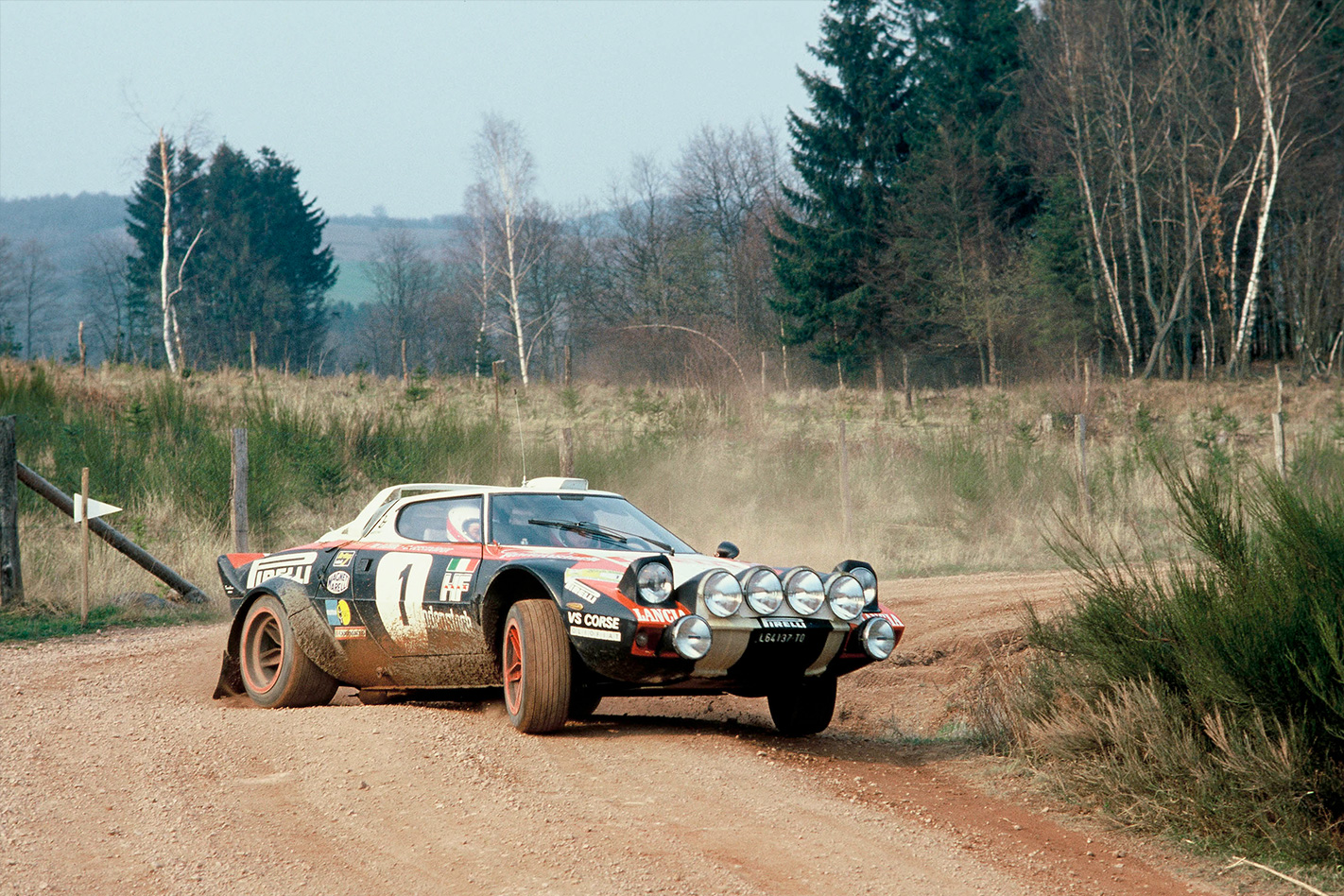
Cars weren’t numbered sequentially, with Bertone’s records showing only 141 shells built at the time of homologation in October 1974. Rumour has it that the FIA inspected a batch of several hundred Stratos in front of Lancia’s Chivasso facility before lunch. Of course, after lunch, a ‘second’ batch was ready and waiting out back…
As a road car, the Stratos HF remained incredibly responsive yet surprisingly civilised. “For the sheer sports car that it obviously is, the Stratos copes remarkably well with the imposed role of gentle tourer,” Fraser reported. The interior was utilitarian, with firm bucket seats and a clear and simple dash.
Rally-critical temperature and pressure gauges were centralised, offsetting the speedo and rev-counter. Also pointers to its rallying genesis was space for additional (re: competition) switchgear and helmet-sized door pockets. There’s actually a decent boot too, with the spare alloy up front in familiar Gandini layout.
The Stratos competition package was initially challenging to sort, with the rear suspension – which failed on its first two competition outings – demanding fine-tuning. It evolved into an adaptable and responsive road car with excellent body control matched with sharp steering and that tractable, smooth Dino V6.

It was formidable to its opponents but could also be to the person behind the wheel. To drive it truly fast, it demanded intense concentration with slight steering inputs and throttle balance that only a few could summon. Forward vision was excellent – rearward, not so. Yet it’s first and foremost a rally car.
To say the Stratos was a success is to say pasta is popular in Italy. It amassed an unprecedented trophy cabinet and earned Lancia the first of three consecutive World Rally Championships in 1974. It won the Targo Florio that year, too, and would win the Tour de France five times and Giro d’Italia twice to also be a circuit-racing success.
In 1975 the iconic green, white and red Alitalia livery with yellow wheels appeared, one of rallying’s most popular pin-ups, the colours worn as the Stratos won the Monte Carlo rally in ’75, ’76 and 1977. Even after the factory withdrew support, the Stratos kept winning with privateers into the early 1980s.
Nothing could stop the incomparable Stratos, whether an oil crisis or bitter Fiat execs. Unimaginable today, it was a masterpiece of determined, unorthodox thinking. It rewrote the rallying rulebook, permanently altering the sport while redefining performance cars along the way. The Lancia Stratos HF left an indelible stamp on automotive history that few, if any, can hold a candle to. The struggle was worth it.

Lancia Locale
Legendary the world over, the Stratos was a rare sight on Australian stages. Rally legend and Bathurst winner Colin Bond drove a Stratos as the Zero car at Rally Australia, but never competed. Ron Marks and co-driver Graeme Gillies campaigned a yellow Stratos in several events, including the highly regarded Southern Cross Rally in 1976 and ‘78, as well as the Castrol International Rally in Canberra. Their best posted result was a fourth the Warana Rally in Queensland, 1976.
Copy, Paste
Only a handful Stratos HFs have made it to Australia. With prime examples fetching beyond $1 million, more affordable replicas are available if you don’t consider this sacrilege. The ‘New Stratos’, with 25 built by Manifattura Automobili Torino (MAT), is priced similarly to a genuine Stratos given its Ferrari F430 donor car. Hawk Cars and LB Specialist Cars produce kit versions in the UK using Alfa, Toyota and Ferrari engines. Strictly POA, used examples have changed hands for around £70k.

